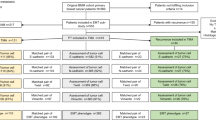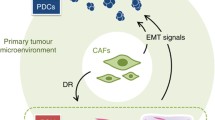Abstract
Most cancer deaths are due to metastases. Markers of epithelial-mesenchymal transition (EMT) measured in primary tumor cancer cells could be helpful to assess patient risk of metastatic disease, even among those otherwise diagnosed with local disease. Previous studies of EMT markers and patient outcomes used inconsistent methods and did not compare the clinical impact of different expression cut points for the same marker. Using digital image analysis, we measured the EMT markers Snail and E-cadherin in primary tumor specimens from 190 subjects in tissue microarrays from a population-based prospective cohort of colorectal cancer patients and estimated their associations with time-to-death. After measuring continuous marker expression data, we performed a systematic search for the cut point for each marker with the best model fit between dichotomous marker expression and time-to-death. We also assessed the potential clinical impact of different cut points for the same marker. After dichotomizing expression status at the statistically-optimal cut point, we found that Snail expression was not associated with time-to-death. When measured as a weighted average of tumor cores, low E-cadherin expression was associated with a greater risk of dying within 5 years of surgery than high expression (risk difference = 33 %, 95 % confidence interval 3–62 %). Identifying a clinically-optimal cut point for an EMT marker requires trade-offs between strength and precision of the association with patient outcomes, as well as consideration of the number of patients whose treatments might change based on using the marker at a given cut point.

Similar content being viewed by others
References
Weinberg RA (2007) The biology of cancer. Garland Science, New York
Young PE et al (2014) Early detection of colorectal cancer recurrence in patients undergoing surgery with curative intent: current status and challenges. J Cancer 5(4):262–271
Hanahan D, Weinberg RA (2011) Hallmarks of cancer: the next generation. Cell 144(5):646–674
Kalluri R, Weinberg RA (2009) The basics of epithelial-mesenchymal transition. J Clin Investig 119(6):1420–1428
Thiery JP et al (2009) Epithelial-mesenchymal transitions in development and disease. Cell 139(5):871–890
Busch EL, McGraw KA, Sandler RS (2014) The potential for markers of epithelial-mesenchymal transition to improve colorectal cancer outcomes: a systematic review. Cancer Epidemiol Biomark Prev 23(7):1164–1175
Ayanian JZ et al (2004) Understanding cancer treatment and outcomes: the Cancer Care Outcomes Research and Surveillance Consortium. J Clin Oncol 22(15):2992–2996
Malin JL et al (2006) Understanding cancer patients’ experience and outcomes: development and pilot study of the Cancer Care Outcomes Research and Surveillance patient survey. Support Care Cancer 14(8):837–848
Kang M et al (2013) Somatic gene mutations in African Americans may predict worse outcomes in colorectal cancer. Cancer Biomark 13(5):359–366
Berglund L et al (2008) A genecentric human protein atlas for expression profiles based on antibodies. Mol Cell Proteomics 7(10):2019–2027
Yao D, Peng S, Dai C (2013) The role of hepatocyte nuclear factor 4alpha in metastatic tumor formation of hepatocellular carcinoma and its close relationship with the mesenchymal-epithelial transition markers. BMC Cancer 13:432
Greenland S, Pearl J, Robins JM (1999) Causal diagrams for epidemiologic research. Epidemiology (Cambridge, Mass) 10(1):37–48
He X et al (2013) Downregulated E-cadherin expression indicates worse prognosis in Asian patients with colorectal cancer: evidence from meta-analysis. PLoS One 8(7):e70858
Benson AB 3rd et al (2004) American Society of Clinical Oncology recommendations on adjuvant chemotherapy for stage II colon cancer. J Clin Oncol 22(16):3408–3419
Rizzardi AE et al (2012) Quantitative comparison of immunohistochemical staining measured by digital image analysis versus pathologist visual scoring. Diagn Pathol 7:42
Rothman KJ (2014) Six persistent research misconceptions. J Gen Intern Med 29(7):1060–1064
Szklo M (1998) Population-based cohort studies. Epidemiol Rev 20(1):81–90
Acknowledgments
This research was funded in part by Grants from the National Institutes of Health (P30 DK034987, U01 CA93326). The Translational Pathology Laboratory is supported in part by grants from the National Cancer Institute (3P30CA016086) and the University of North Carolina at Chapel Hill University Cancer Research Fund. ELB was supported in part by a Grant from the National Cancer Institute (5T32CA009001).
Author information
Authors and Affiliations
Corresponding author
Ethics declarations
Conflicts of interest
The authors have no conflicts of interest to report.
Human and animal rights and informed consent
All procedures performed in studies involving human participants were in accordance with the ethical standards of the institutional and/or national research committee and with the 1964 Helsinki declaration and its later amendments or comparable ethical standards. Informed consent was obtained from all individual participants included in the study.
Electronic supplementary material
Below is the link to the electronic supplementary material.
Rights and permissions
About this article
Cite this article
Busch, E.L., Keku, T.O., Richardson, D.B. et al. Evaluating markers of epithelial-mesenchymal transition to identify cancer patients at risk for metastatic disease. Clin Exp Metastasis 33, 53–62 (2016). https://doi.org/10.1007/s10585-015-9757-7
Received:
Accepted:
Published:
Issue Date:
DOI: https://doi.org/10.1007/s10585-015-9757-7




